Summary of the Day:
In a major escalation, NATO Secretary General Mark Rutte confirmed that North Korean military units are now operating in Russia’s Kursk Oblast, based on evidence shared by South Korean intelligence officials. Ukrainian intelligence reports indicate Russian forces are moving North Korean personnel along the E38 Kursk-Voronezh highway using civilian vehicles, though Ukrainian forces have not yet engaged them in combat.
Russian forces achieved marginal advances near Kupyansk, southeast of Pokrovsk, and southwest of Donetsk City. Meanwhile, Ukrainian forces conducted strategic drone strikes against Russian distilleries on October 27-28, targeting facilities in Voronezh Oblast including the Ethanol Spirit distillery in Krasnoye, which produces components for Russian aviation systems.
In Moscow, President Putin acknowledged growing economic challenges including labor shortages, while attempting to project confidence by highlighting a claimed 2.4% unemployment rate. Despite Putin’s assertions about focusing on economic development, draft budgets reveal plans to spend 41% of annual expenditures on defense and security in 2025, as several prominent Russian figures express concern over the Central Bank’s decision to raise interest rates to 21%.
In regional developments, Georgia saw large-scale protests in Tbilisi as opposition leaders and international observers rejected the 2024 parliamentary election results, while Moldova’s Constitutional Court prepared to review its recent EU referendum results ahead of a presidential runoff election.
Picture of the Day:
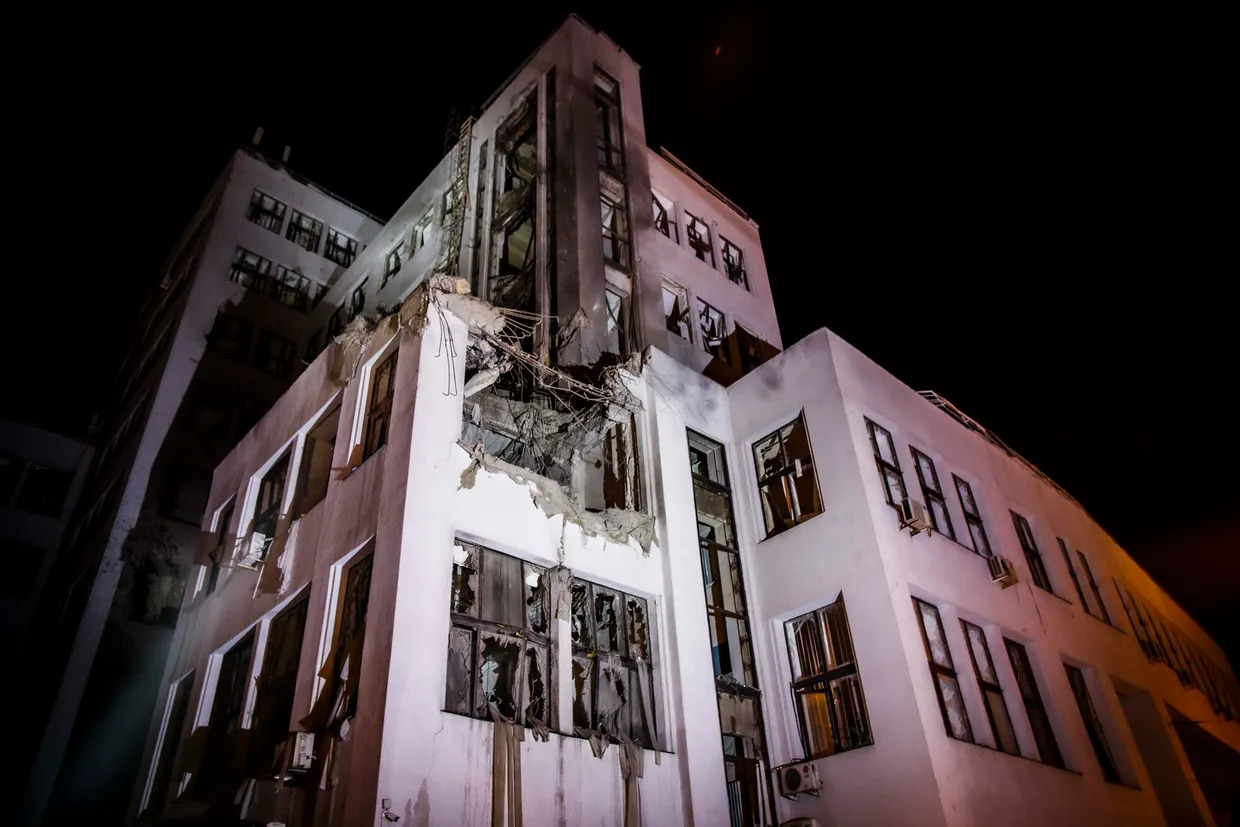 Russian forces struck downtown Kharkiv, injuring at least nine people and damaging the historic Derzhprom Building. Russia launched a series of attacks against residential neighborhoods in Ukraine’s cities striking Kharkiv, Kyiv, and Kryvyi Rih. (Hermes Pichon / The Kyiv Independent)
Russian forces struck downtown Kharkiv, injuring at least nine people and damaging the historic Derzhprom Building. Russia launched a series of attacks against residential neighborhoods in Ukraine’s cities striking Kharkiv, Kyiv, and Kryvyi Rih. (Hermes Pichon / The Kyiv Independent)
Beyond Ukraine – The March Towards World War
NATO Secretary General Mark Rutte announced that South Korean intelligence has confirmed North Korean military units operating in Russia’s Kursk Oblast near the Ukrainian border, with troop numbers increasing from 3,000 to approximately 10,000 soldiers, and plans to deploy up to 12,000 troops including 500 officers and three generals. According to Ukrainian intelligence, Russian forces are moving North Korean personnel along the E38 Kursk-Voronezh highway using civilian vehicles, though Ukrainian forces have not yet engaged them in combat. While both Russia and North Korea initially denied these troop movements but have since become less direct in their responses, Pentagon spokesperson Sabrina Singh and Western leaders have verified the deployments, with President Zelensky warning that Ukrainian forces will face North Korean soldiers in Europe by late October. In response, Rutte plans to meet with South Korean President Yoon Suk Yeol and Ukrainian Defense Minister Rustem Umerov to discuss what he called a “significant escalation” in Russia’s war effort and a threat to both Indo-Pacific and Euro-Atlantic security, while the U.S. plans to provide Ukraine with $700-800 million in aid for domestic weapons production.
Moldova’s Constitutional Court will review the October 20 EU referendum results on October 31, with a deadline to confirm or reject them by November 4, while in the November 3 presidential runoff, pro-EU incumbent President Maia Sandu (42.49%) faces former prosecutor general Alexandr Stoianoglo (25.95%), with third-place finisher Renato Usatii (213,169 votes) announcing he won’t endorse either candidate, though three other candidates with fewer votes have endorsed Stoianoglo. During a recent debate, Stoianoglo, who is from the pro-Russian Gagauzia region and is backed by the Party of Socialists and former pro-Russian president Igor Dodon, claimed he would support Ukraine and strengthen relations, but Sandu dismissed this, calling him “Moscow’s man,” while Moldovan authorities have accused Moscow and pro-Russian oligarch Ilan Shor of attempting to influence the election against Sandu, who has consistently supported Ukraine and led Moldova toward EU integration.
Georgian President Salome Zourabichvili joined thousands of protesters in Tbilisi’s Freedom Square after the pro-Russian Georgian Dream party claimed victory with 54.08% of the vote in the October 26 parliamentary elections, despite exit polls favoring the pro-European opposition coalition. Opposition member Giorgi Vashadze called for internationally administered snap elections, while Russian officials celebrated the ruling party’s victory and demanded Zourabichvili’s arrest for “calling for a coup,” as Pro-Russian Prime Minister Irakli Kobakhidze stated the parliament will proceed despite protests. Both EU diplomat Josep Borrell and U.S. Secretary of State Antony Blinken have called for investigations into reported irregularities, with international observers noting numerous violations including pre-filled ballots and voter intimidation, while a U.S. intelligence source suggested Russian interference with election servers.
The electoral controversy has strained Georgia’s relationships with both the EU and U.S., particularly following Georgia’s adoption of a foreign agents law that has impeded its EU candidacy status, as 28 EU ministers issued a statement noting that the electoral irregularities are incompatible with EU candidate country standards, potentially jeopardizing Georgia’s EU membership prospects, while the US State Department warned of possible consequences for Georgian officials if democratic violations continue, setting up a significant political confrontation that could determine Georgia’s alignment between Russia and the West.
According to Belarusian Special Operations Forces Commander Major General Vadim Denisenko, China has been learning Russian military tactics through exercises in Belarus. On October 27, he reported that Chinese, Uzbek, and Kazakh forces have participated in Belarusian military drills over the past few months, focusing on drone usage, trench warfare, and urban combat techniques learned from the Ukraine war.
South Africa is attempting to maintain neutrality in the Russia-Ukraine war, despite President Ramaphosa’s recent comments at a BRICS summit in Kazan calling Russia a “valuable friend and ally.” The statement caused controversy within South Africa’s coalition government, with the Democratic Alliance opposing this characterization of Russia. South Africa, Africa’s largest economy, maintains historic ties with Russia dating back to the anti-Apartheid struggle. In an effort to balance relations, South African Foreign Minister Ronald Lamola is set to meet with Ukrainian counterpart Andriy Sybiga to discuss visa waivers for South African officials attending peace formula meetings in Ukraine.
The Path to Peace
Donald Trump’s team plans to end Russia’s war in Ukraine by freezing the conflict if he wins the U.S. presidency. The proposed plan would revise the failed Minsk agreements, creating autonomous regions along a demilitarized zone, with European troops (not NATO or UN) enforcing the agreement. Trump’s team suggests Ukraine would not cede territory officially but would need to pause NATO aspirations. Key aspects include U.S. non-involvement in enforcement, European funding, and possible economic pressure on Russia through oil prices. Critics within the Republican Party are divided on this approach, though Trump’s advisers point to his previous diplomatic successes like the Abraham Accords as evidence of his negotiating ability.
Situation On The Land, Sea, and Air in Ukraine
Ukraine is seeking ways to disrupt Russia’s expected winter missile campaign while being restricted from using Western weapons for deep strikes into Russia. Recent Ukrainian drone attacks have successfully targeted Russian ammunition warehouses, causing significant losses, including a major explosion in Tver Oblast. Ukraine has also begun targeting ethanol distilleries, which produce alcohol needed for military aviation operations, though experts like Peter Layton suggest this strategy may have limited impact due to Russia’s ability to source ethanol elsewhere. While Ukrainian forces have had success with drone strikes on less-protected targets, they face challenges in attacking well-defended sites like airbases, particularly since Russia has moved 90% of its aircraft out of range of Western-supplied missiles.
Ukraine’s military intelligence (HUR) reports that Ukrainian forces and resistance fighters sabotaged a key railway bridge in Russian-occupied Berdiansk, Zaporizhzhia Oblast. The bridge, located between the Vodokanal utility building and a car wash on Skhidnyi Avenue, reportedly served as a crucial transport route for Russian military supplies and looted Ukrainian resources. While Russian state media claims the explosions were military exercises and denies any damage, Ukrainian sources maintain the bridge’s destruction has cut off railway access to the occupied port city. However, no visual evidence has been provided by either side to confirm the bridge’s status.
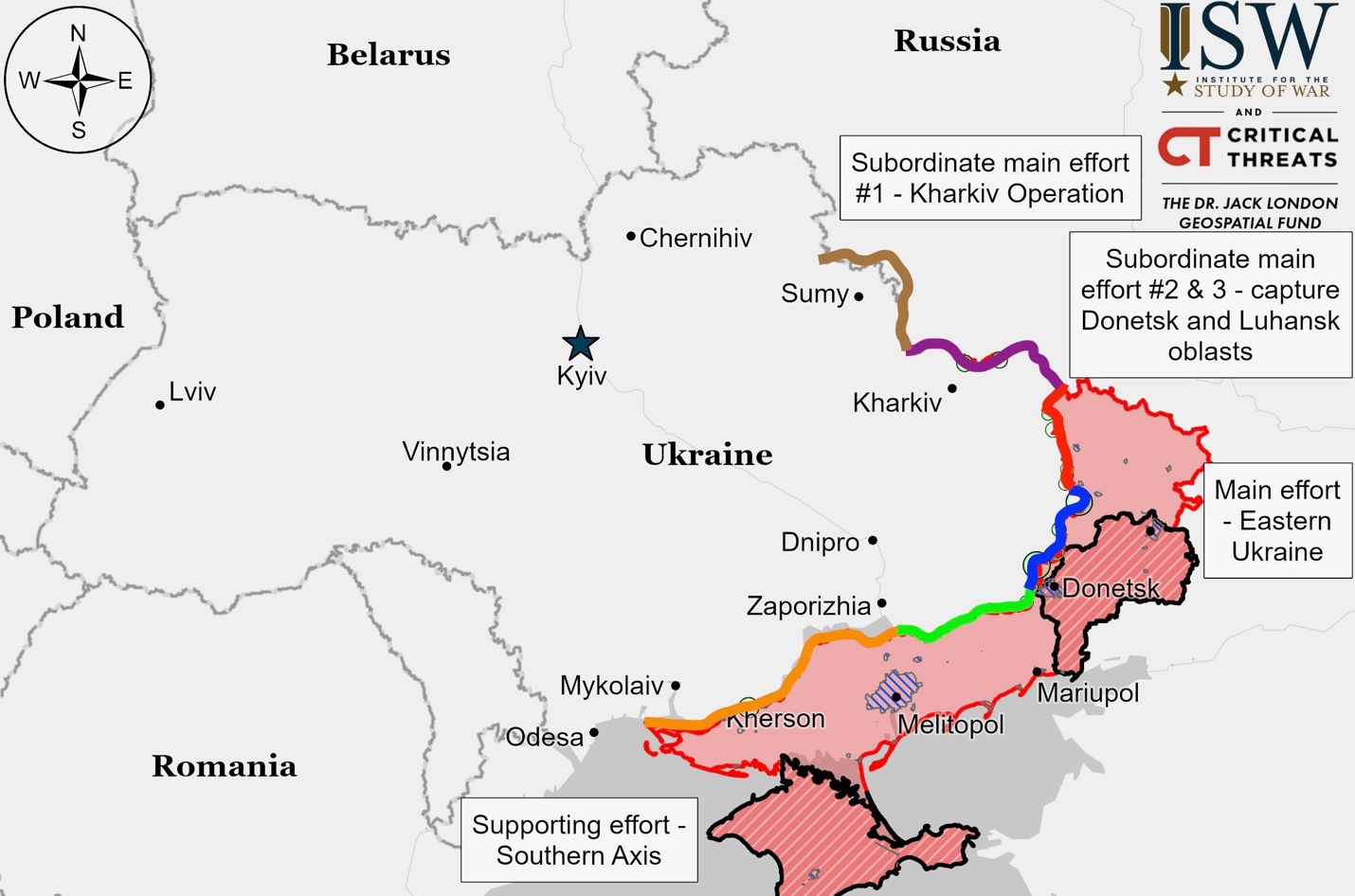
Ukrainian Operations in the Russian Federation – Initiative None
Combat operations continued in Ukraine’s Kursk Oblast salient. While Russian sources claimed advances near Novoivanovka and reported Ukrainian counterattacks near several settlements (including Kremyanoye, Nizhny Klin, Alexandriya, Lyubimovka, Darino, Russkaya Konopelka, and Plekhovo), no changes to the frontline could be independently confirmed. Russian airborne units were reported operating near Zeleny Shlyakh.
Combat continued in Ukraine’s Glushkovsky Raion, with conflicting reports about the situation near Novy Put. While one Russian source claimed Ukrainian forces failed to advance there, another indicated Russian forces hadn’t fully cleared the area. Ukrainian sources reported conducting a mechanized assault east of Novy Put using three armored vehicles. However, no confirmed changes to the frontline were reported.
Russian officials reported intercepting what they described as a border crossing attempt near Manev in Bryansk Oblast’s Klimovsky Raion. Bryansk Governor Alexander Bogomaz stated that Russian military, FSB, and Rosgvardia forces repelled the group, which the FSB later characterized as a “sabotage and reconnaissance group.”
Ukrainian forces launched drone strikes against Russian distilleries hitting targets in Voronezh Oblast including the Ethanol Spirit distillery in Krasnoye. According to Ukrainian Counter-Disinformation Head Andriy Kovalenko, these distilleries produce rocket fuel, aviation brake system components, and anti-icing agents. The strikes are part of Ukraine’s strategy to reduce Russian aviation capabilities, following similar attacks on distilleries in Tula Oblast a week earlier.
Kharkiv Front – Initiative Russia
Russian forces continued limited attacks near Vovchansk northeast of Kharkiv City but failed to advance. Military observer Kostyantyn Mashovets reported that Russian forces in this area are split between northern Kharkiv Oblast and Kupyansk operations. Their objectives reportedly include capturing northern Vovchansk, advancing toward Tykhe and Lyptsi, retaking Hlyboke, and tying down Ukrainian forces to prevent their deployment to Kursk Oblast and Kupyansk.
Nearly 80% of buildings in Vovchansk, Kharkiv Oblast, have been destroyed or damaged since Russia’s latest offensive began in May 2024, according to a joint Bellingcat-AFP investigation. The town, located just 5 kilometers from the Russian border, has faced repeated attacks since Russia’s initial invasion, including an occupation period that ended in autumn 2022. Only 22% of buildings remain intact, with significant damage to civic buildings including a library, school, and church.
Luhansk Front – Initiative Russia
Russian forces made slight advances southeast of Kupyansk, specifically within Kolisnykivka and near Kruhlyakivka. Russian sources claimed advances near multiple settlements including Pishchane, Stepova Novoselivka, Zahryzove, Stelmakhivka, Terny, and Torske. Russian forces continued attacks along the Kupyansk-Svatove-Kreminna line, with assaults reported near numerous settlements including Kindrashivka, Synivka, and Petropavlivka.
Donetsk Front – Initiative Russia
Russian forces have reported new gains in eastern Ukraine’s Donbas region, taking control of Selydove’s residential district and claiming capture of nearby Ismailivka. Ukrainian forces are retreating under pressure, with fighting reported in multiple locations including Vyshneve, which is largely under Russian control. The attacks are focused on the Pokrovsk-Kurakhove sector, where Russian forces conducted over 600 assaults in the past week, supported by artillery, missiles, and more than 600 air strikes. The Kremlin’s main objective is to take over Ukraine’s Donbas and Luhansk regions, with particular interest in Pokrovsk’s industrial facilities and Kurakhove’s power station. Ukrainian military reports indicate they continue to defend their territory, though facing significant pressure from superior Russian numbers and firepower.
Siversk
Russian and Ukrainian military sources did not report any ground combat operations in the Siversk area.
Chasiv Yar
Russian forces attacked multiple locations around Chasiv Yar, including Orikhovo-Vasylivka to the northeast and the settlements of Stupochky and Predtechyne to the south. No changes to the frontline were confirmed.
Toretsk
Russian forces attacked Toretsk and nearby settlements of Niu-York and Shcherbynivka. While a Russian military blogger claimed Russian advances in central Toretsk and Ukrainian counterattacks near Sverdlov Street, these reports remain unconfirmed. There were no confirmed changes to the frontline.
Pokrovsk
Russian forces advanced near Pokrovsk capturing territory north of Selydove, within Vyshneve, and near Novodmytrivka. The Russian military claimed to have seized Tsukuryne. Russian forces conducted assaults near multiple settlements including Myrolyubivka, Promin, Krutyi Yar, Selydove, Kurakhivka, Novoselydivka, and Vyshneve. A Ukrainian commander reported that Russian forces maintain significant troop numbers for continuous assaults in the Selydove area, with approximately 600 troops deployed weekly for infantry attacks.
Kurakhove
Russian forces attacked near Maksymilyanivka and around Kurakhove with no confirmed changes to the frontline.
Southwest of Donetsk City
Russian forces advanced near Vuhledar, with confirmed movements southwest of Yelyzavetivka and Katerynivka, and northeast of Shakhtarske. Russian forces attacked multiple settlements including Katerynivka, Antonivka, Bohoyavlenka, Novoukrainka, Shakhtarske, and Zolota Nyva.
Zaporizhia Front – Initiative Russia
Zaporizhia-Donetsk Border Area
Neither Russian nor Ukrainian sources reported fighting in the Donetsk-Zaporizhia Oblast border area.
Zaporizhia Line
No fighting was reported in western Zaporizhia Oblast. Russian forces are positioned near Robotyne and Mala Tokmachka.
Kherson (Dnipro River) Front – Initiative Russia
Russian forces continued attacks along the Dnipro River in eastern Kherson Oblast, including the river’s delta islands.
Ukraine News
Russia launched 100 drones against Ukraine overnight. Ukrainian forces shot down 66 drones across 13 regions, while some drones hit civilian targets, including homes in Kharkiv City and Chuhuiv. Twenty-four drones were lost, and four entered Russian and Belarusian airspace.
Innocent Victims Of War
The casualty count of civilians in the past 24 hours: (Russian War Crimes)
DEATHS: 10 INJURIES: 46
Russian forces struck downtown Kharkiv hitting the historic Derzhprom building in Freedom Square with a FAB-500 bomb. The attack injured nine people, including a police officer, and damaged a medical facility and other administrative buildings. The Derzhprom, a UNESCO-protected constructivist landmark and the Soviet Union’s first skyscraper, survived World War II but was severely damaged in this strike.
Hours later, Russia launched a Grom-E1 hybrid missile attack on Kharkiv’s Osnovianskyi district killing four people – two women and two men. The strike destroyed one house and damaged 19 others. Emergency services continue searching for possible victims, including children, who may be trapped in the rubble. Four cars were also damaged in the attack.
A Russian missile strike on Kryvyi Rih, President Zelensky’s hometown and only 28 miles (45 km) from where I was staying, killed one person and injured 14 others. The attack damaged 11 apartment buildings, a medical clinic, a school, and several other structures, including a gas pipeline. Five people were rescued from a partially destroyed high-rise building. One victim remains in intensive care, while others are in stable condition.
A Russian drone attack on Kyiv injured six people, with one hospitalized with a serious leg injury. The strike hit a 9-story apartment building in the Solomianskyi district, damaging a gas pipe and causing a fire that spread to a nearby shop and cars. Fifteen people were evacuated. Additional drone debris damaged windows in the Sviatoshynskyi district.
Russian forces struck Kherson Oblast, targeting infrastructure, a medical facility, and residential areas, killing five people and injuring 13, including one child.
Russian attacks in Zaporizhzhia Oblast injured three people – one woman and two men – and damaged seven buildings.
Russian strikes in Donetsk Oblast injured one person and damaged over 50 buildings.
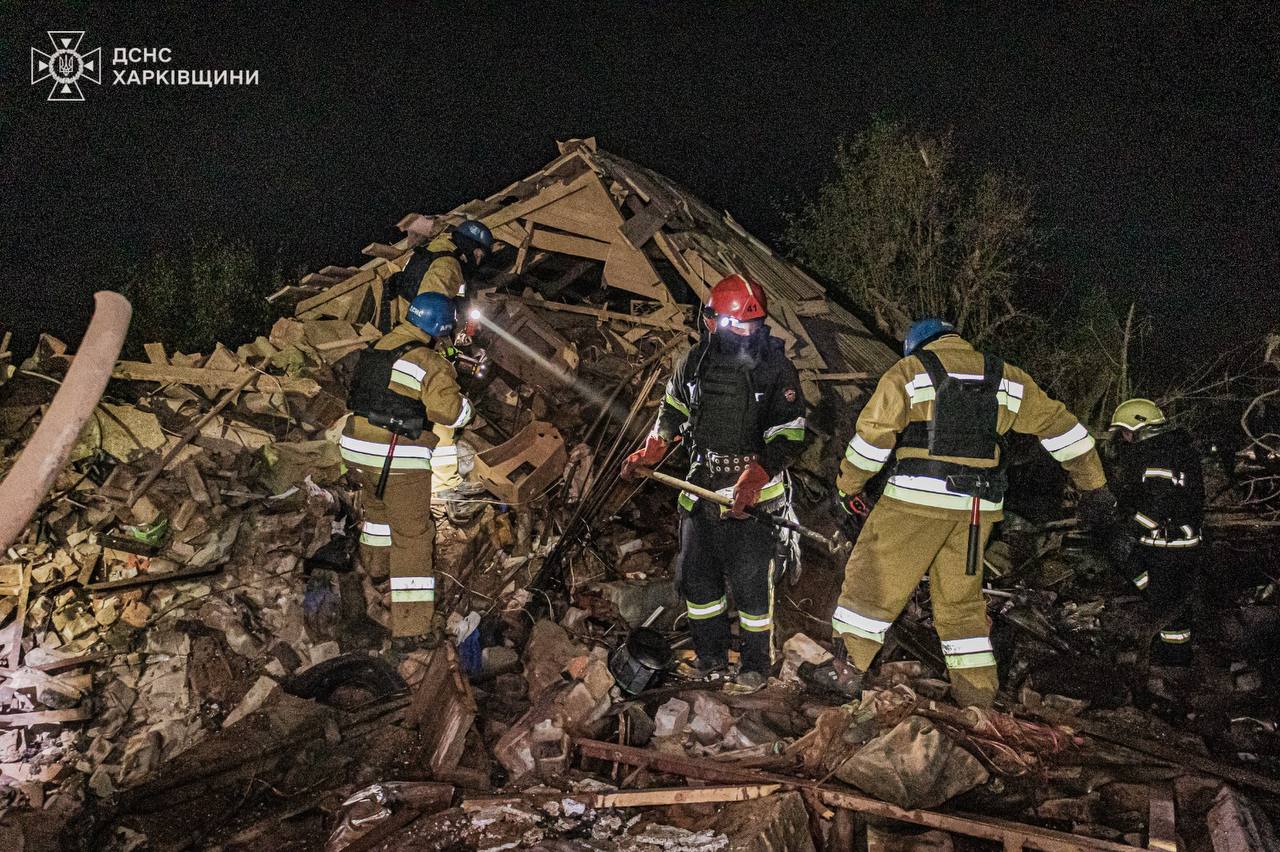 Emergency workers dig through the rubble of a destroyed house after a Russian attack against Kharkiv. (State Emergency Service / Telegram)
Emergency workers dig through the rubble of a destroyed house after a Russian attack against Kharkiv. (State Emergency Service / Telegram)
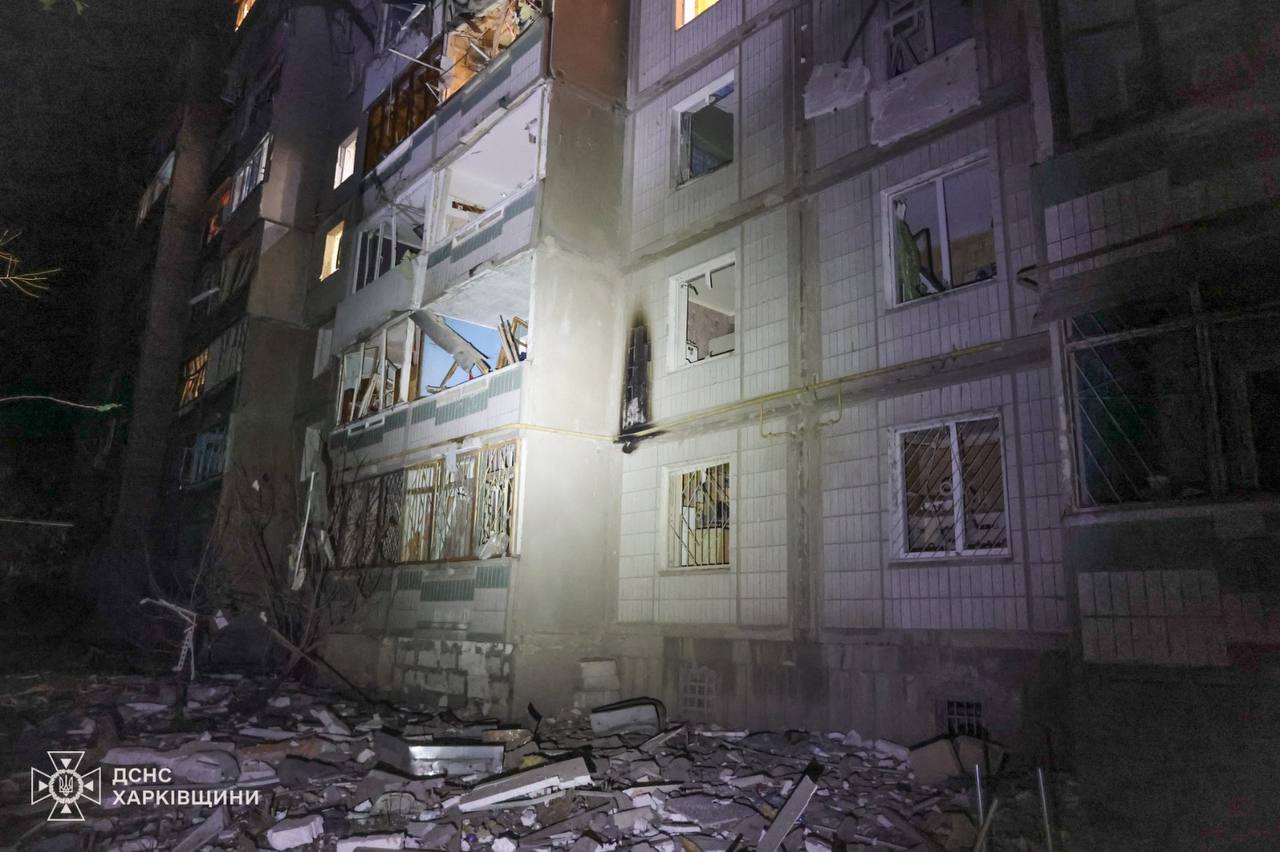 A building damaged in a Russian attack on Kharkiv, Ukraine. (State Emergency Service/Telegram)
A building damaged in a Russian attack on Kharkiv, Ukraine. (State Emergency Service/Telegram)
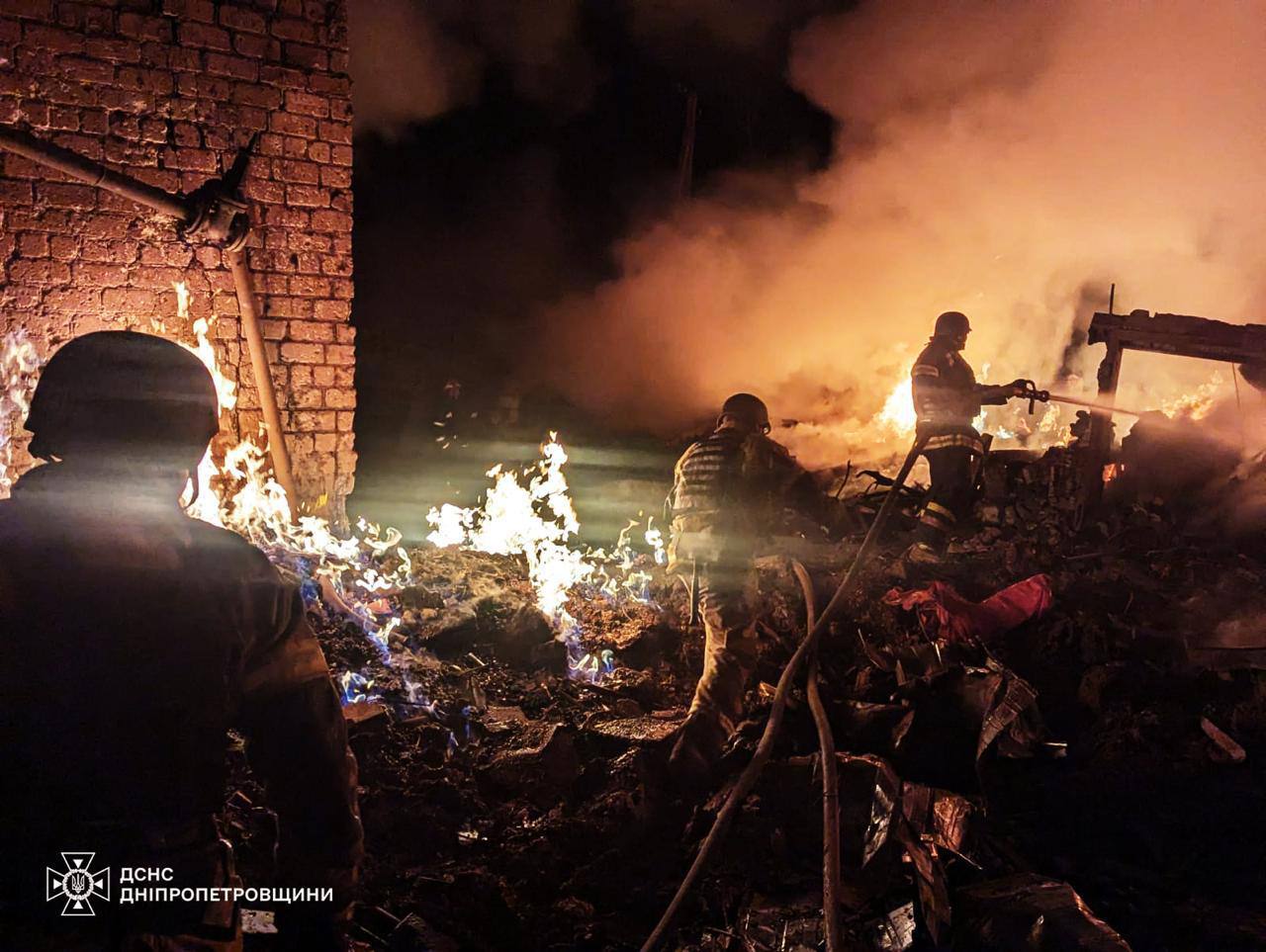 Russia struck the city of Kryvyi Rih in Dnipropetrovsk Oblast, damaging several residential buildings. (Emergency Service of Ukraine / Telegram)
Russia struck the city of Kryvyi Rih in Dnipropetrovsk Oblast, damaging several residential buildings. (Emergency Service of Ukraine / Telegram)
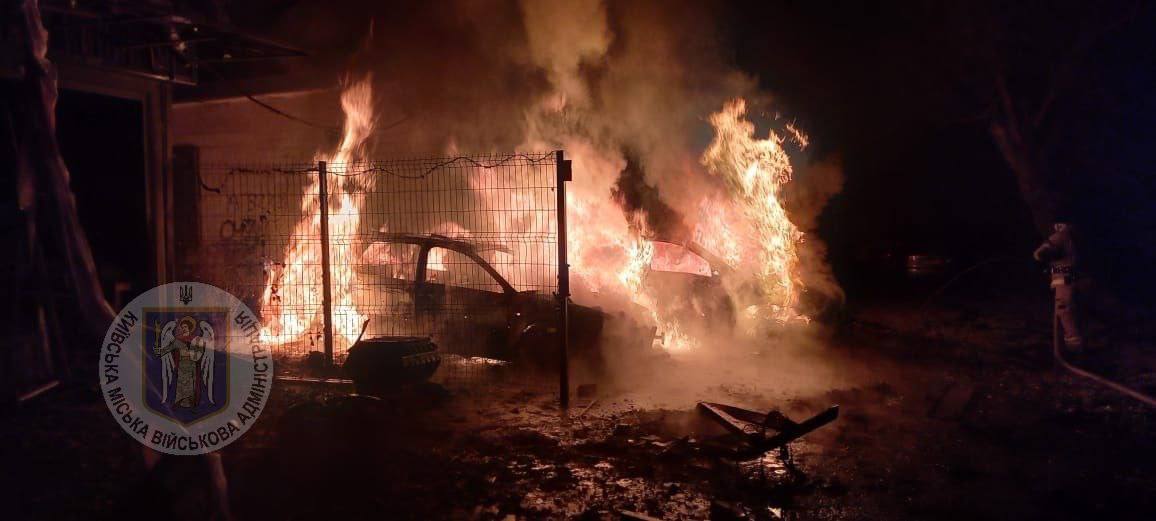 Vehicles on fire after a Russian drone attack against Kyiv. (Kyiv City Military Administration / Telegram)
Vehicles on fire after a Russian drone attack against Kyiv. (Kyiv City Military Administration / Telegram)
Ukrainian Mobilization and Industrial Defense Base
Rheinmetall, the German defense company, has begun producing Lynx infantry fighting vehicles at its first Ukrainian facility, which previously focused on vehicle repairs. CEO Armin Papperger announced that about ten vehicles will be delivered by year’s end. A second factory is nearly complete, and two more facilities for ammunition and propellant production are being planned. The Lynx KF41 being built in Ukraine is a 50-ton armored vehicle that can carry eight soldiers, has strong armor protection, and reaches speeds of 70 kph. The company and Ukraine finalized this production agreement in June, marking a significant step in defense collaboration between the two countries.
Ukraine’s Allies
Nearly 200 North Korean defectors living in South Korea, many with military experience, have volunteered to deploy to Ukraine to conduct psychological operations against North Korean troops fighting for Russia, with the group being led by both Ahn Chan-il of the World Institute for North Korea Studies and Lee Min-bok, who believe their understanding of North Korean military culture could help demoralize and potentially turn North Korean soldiers through loudspeaker broadcasts, leaflet distribution, and interpreter services against the approximately 12,000 North Korean troops currently in Russia’s Kursk Oblast. While the Ukrainian embassy has not yet responded to the defectors’ offer, this development comes as South Korea considers reviewing its ban on sending weapons to Ukraine in response to North Korea’s growing military cooperation with Russia, even as Putin has indirectly acknowledged North Korean troops’ presence in Russia while North Korea’s Foreign Ministry remains vague about troop deployments.
President Zelensky visited Iceland for the fourth Ukraine-Northern Europe Summit, meeting with prime ministers from Iceland, Denmark, Sweden, Norway, and Finland. The discussions focus on Ukraine’s victory plan, including weapons production, winter preparation, maritime security, and defense assistance. This marks Zelensky’s first visit to Iceland, following his previous attendance at the Stockholm summit in May. The summit represents an important alliance between Ukraine and Nordic countries in their ongoing support against Russian aggression.
A Helsinki court has ruled that Russian assets in Finland worth tens of millions of dollars must be seized to compensate Ukraine’s Naftogaz. This follows a 2023 Hague court decision ordering Russia to pay $5 billion to Naftogaz for illegally seizing the company’s assets in Crimea during the 2014 occupation. This marks the first enforcement of the Hague ruling in a third country, with interest continuing to accrue until Russia’s full payment is made.
Norway has pledged a new 500-million-euro aid package to Ukraine, with more than half earmarked for military support.
Sweden has pledged $68 million in new military aid to Ukraine. The package includes $46.5 million for Ukraine’s Armed Forces and $21.6 million for defense industry development. This aid could support various military initiatives including fighter jets, maritime security, and mine clearance programs.
Croatia and Germany signed a memorandum for a military exchange deal: Croatia will receive Leopard 2A8 tanks in return for sending military equipment to Ukraine. Under the agreement, Croatia will provide Ukraine with 30 M-84 tanks and 30 M-80 infantry fighting vehicles, plus spare parts and ammunition. In exchange, Croatia can purchase up to 50 Leopard 2A8 tanks from Germany at a reduced price.
While the U.S. will maintain existing restrictions on Ukraine’s use of American weapons for deep strikes into Russia, it won’t add new limitations if North Korean troops enter combat. U.S. President Biden called the situation “very dangerous,” and the U.S. plans to provide Ukraine with $700-800 million in aid for domestic production of long-range capabilities.
In a CBS News interview, Republican vice-presidential candidate J.D. Vance downplayed concerns about Russian election interference ahead of the November 5 U.S. presidential election. When asked about a fake video targeting Trump voters in Pennsylvania, which U.S. officials confirmed was Russian disinformation, Vance dismissed the issue, saying “a lot of countries” try to manipulate elections. He also described Putin as a “competitor” rather than an enemy and criticized sanctions against Russia. The election outcome could significantly impact future U.S. military support for Ukraine, as Vance has been a vocal critic of aid to Kyiv.
U.S. support for Ukraine might decrease regardless of who wins the November 5 presidential election. Even if Democratic candidate Kamala Harris wins, she would likely face challenges passing Ukraine aid through Congress. The Republican-led House has already delayed a $61 billion aid package, contributing to Ukraine’s military setbacks, including the loss of Avdiivka. House Speaker Mike Johnson has expressed reluctance for further Ukraine funding. While the U.S. has provided $175 billion in total assistance since 2022 ($64 billion in military aid), growing Western fatigue and congressional resistance suggest continued support may be difficult to maintain, even under a Democratic administration.
Russia News
Russian President Vladimir Putin addressed Russia’s economic challenges while attempting to present a positive outlook. He highlighted a claimed 4.5 percent industrial growth in early 2024 and a record-low unemployment rate of 2.4 percent. However, Putin acknowledged “difficulties and imbalances” including international sanctions, personnel shortages, and technological limitations. While Putin promised the 2025-2027 federal budget would focus on economic development and job creation, draft bills show about 41 percent of annual expenditures are planned for defense and security. Meanwhile, several prominent Russian political and business figures have expressed concern over the Central Bank’s decision to raise interest rates to 21 percent, suggesting growing strain on Russia’s economy and its ability to sustain the war effort.
The posthumous release of Alexei Navalny’s memoir “Patriot” on October 22 has reignited discussions about his complex legacy, particularly regarding Ukraine-Russia relations. While Navalny condemned Russia’s full-scale invasion of Ukraine from prison and eventually supported returning Crimea to Ukraine, his earlier statements and views often reflected ambivalent attitudes toward Ukrainian sovereignty. His widow, Yulia Navalnaya, now emerging as a prominent opposition figure, has also sparked controversy by questioning the arming of Ukraine. The memoir, which Navalny wrote while imprisoned and smuggled out through his lawyers before his death on February 16, highlights his focus on fighting Russian corruption but also reveals the challenges facing Russian opposition leaders in fully acknowledging Ukraine’s right to independence and the Russian people’s collective responsibility for the war.
Russian War Losses (Today/Total)
President Zelensky reports that Russia has suffered 650,000 military casualties in Ukraine since February 2022, including killed and wounded. Estonian intelligence estimates 40,000 Russian losses in October alone. According to Zelensky, Russian forces are using human wave attacks and leaving their dead on the battlefield, with some soldiers reportedly killed by their own army for retreating.
| Troops +1680
690720 |
Tanks +7
9120 |
Artillery +51
19872 |
Arm. VEH +40
18395 |
Aircraft
369 |
Heli
329 |
Ships
28 |
Russian Mobilization and Defense Industrial Base
Russian authorities announced that gun owners with minor criminal records can now receive pardons by donating their weapons for use in Ukraine. This “pardon-for-weapons” program, announced by Rosgvardia (Russia’s National Guard), follows a similar pattern where Russia has been offering to commute criminal sentences in exchange for military service. Rosgvardia has been accepting civilian weapons for combat use in Ukraine since August 2024.
The Mayor of Novosibirsk, Maxim Kudryavtsev, approved a resolution on October 24 offering city employees a one-time payment of 100,000 rubles (approximately $1,023) for signing military contracts. This is part of Russia’s ongoing efforts to boost military recruitment through financial incentives, which is reportedly putting additional pressure on the country’s wartime economy.
Russia’s Allies
Belarusian President Alexander Lukashenko met with Sakhalin Oblast Governor Valery Limarenko, calling for greater cooperation on import substitution – likely an effort to help Russia evade international sanctions.
North Korea is supplying Russia with weapons valued between $1.7-$5.5 billion to support Russia’s war in Ukraine, according to a new Friedrich Naumann Foundation study. The partnership includes North Korean troops joining Russian forces, though large-scale troop deployment is considered unlikely due to risks to North Korea’s stability. Diplomatic meetings between the two countries have increased significantly, with over 24 high-level meetings in 2024 compared to the historical average of less than five. Russia’s primary motivation is accessing ammunition supplies, while also using the partnership to challenge Western alliances in East Asia, particularly pressuring South Korea and Japan to reconsider their support for Ukraine.
Source Material
Institute for the Study of War – understandingwar.org
The Kyiv Independent – kyivindependent.com
Kyiv Post – kyivpost.com
